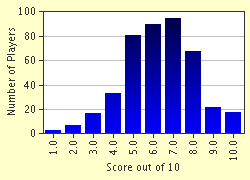Quiz Answer Key and Fun Facts
1. What is the name of the law in which umpires abide by when making a decision?
2. What is the maximum amount of players allowed on the interchange bench at any AFL game?
3. Which of the following statements apply to marking contests?
4. If a knock to the arm causes a player to lose the ball, the tackler shall get a free kick.
5. As an example, if the ball is kicked towards the behind post and the boundary umpire blows it out of bounds, and the goal umpire thinks there is a point scored. Who gets to make the call?
6. What is the distance (to the nearest metre) between the goal posts?
7. Which of the following offences cannot be a 50 metre penalty?
8. When does a player have to leave the ground under a 'blood rule'?
9. Can there be a mark if the ball deflects off an umpire or runner?
10. Which of the following is not a case of throwing the football.
Source: Author
skturner
This quiz was reviewed by FunTrivia editor
Nightmare before going online.
Any errors found in FunTrivia content are routinely corrected through our feedback system.


